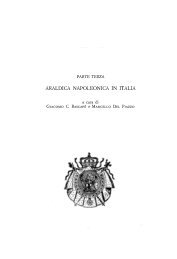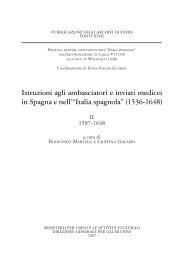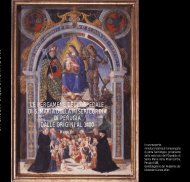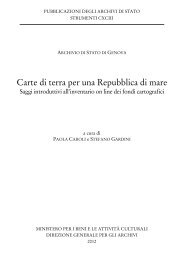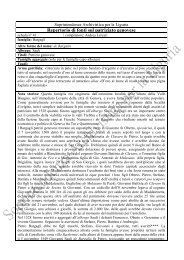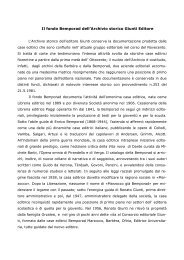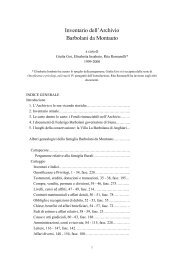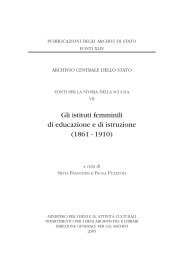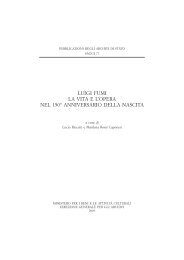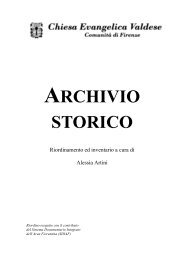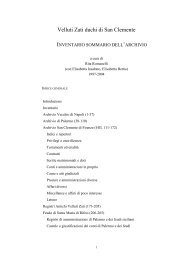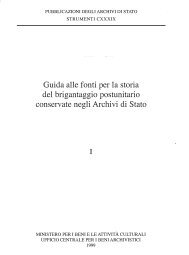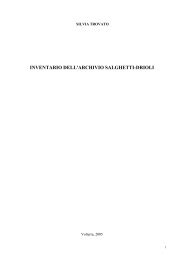ITALIA JUDAICA. Atti del I Convegno internazionale. Bari 18-22 ...
ITALIA JUDAICA. Atti del I Convegno internazionale. Bari 18-22 ...
ITALIA JUDAICA. Atti del I Convegno internazionale. Bari 18-22 ...
You also want an ePaper? Increase the reach of your titles
YUMPU automatically turns print PDFs into web optimized ePapers that Google loves.
In order to assess Rid's argument correctly, we must cast a horizontal<br />
gIance and note th t at this time many haIakhists, particularly in neighboring<br />
southern France and northern Spain, were articuIating a sturdy rationale out<br />
lining tbe importance, permissibility - indeed indispensability _ of inte!<br />
Iectual freedom, individuality' and criticism, If we analyze their treatment<br />
o . f the . the n: e of cOl1ce tuaI"ideationaI progress, in which the crudaI, invigora<br />
tI g d1alec Ic ? f authonty a ? d innovation unfolds, we sha11 acguire a perspe<br />
etIve for vlewmg and asseSSl11g Rid's vigorous presentation of his credo.24<br />
Various epigrams or slogans expressing this concept were to become<br />
;urrenL Many rabbinic authors, Rabad incIuded, speak of melekhe! shamayim<br />
,Iabor far the sake of heaven), WhlCh says that the responsible Talmudist, by<br />
d fmltlOn c ? mmItt d to the weightiness of tradition and precedent, wilI eschew<br />
ffiisplaced dogmatismo Be must be simultaneously cautious and creative<br />
conservative and innovative. On the one hand, he \vi11 not consider himself<br />
ree to desist from reeording a novel interpretation or originaI eonclusion<br />
1ust because no prevous writer mentioned it. Inasmuc as his vie\v may be<br />
.<br />
the eo rect one, h <br />
IS moralIy obligated .lo advanee it, for he is engaged not<br />
ln a prIvate and optlOnal academic enterprise but in melekhe[ shamayim. The Iat<br />
ter lS an lnteilectual nobiesse oblige - speak boldly and responsibly. On the<br />
other hand, the significance and soIemnity of halakhic study will so sen<br />
sltlze and liumble him that he will cite views of predecessors even if oppo.<br />
<br />
ed to hls O\V pOSItlOn. Inasmuch as these opposing views may be correet, he<br />
lS moraily oblrgated to . deflate his own authoritativeness and keep the realm<br />
of . the possIbe and conJectural apen. Melekhe! shamayim) in ShOft, is conco<br />
mitantly a stImulant and a depressant: a spur to originality and inventiveness<br />
ut aIso a l1 : otive f r eonservatism and restraint. We may see it as embodying<br />
ln part the Idea artlculated so cIearly by NaI;manides, upon undertaking to de-<br />
unique argument . for and characterization of rus intelleetual freedom and the faet that he<br />
was - ?ot rooted 111 any firm tradition molded by towering figures. Bis critical bent may<br />
expl m th absence of a schooI, which is certain1y identified with a measure of ad hominem<br />
a glanCe lf not veneration, Ioeal color and pride, hallowed views, etc. The kind of critlclsm<br />
and openness wrueh e endorsed would negate the existence or emergenee of a<br />
school. . Of course, . the questlon of priority remains moot: was the absence of a school<br />
eonucl e to such 1l1dependence or did the inclination to independence forestali the crystallizatlon<br />
. of schooI? The latter assumes that Rid's predecessors shared this inelination.<br />
The TosafIsts . ustrate how individuality and criticism may be combined with traits of a<br />
seho! - COnt1nUlt , m : thodology, etc... Se : nantics nd reality must temper each other.<br />
The followmg lS adapted from the 1l1troductlOn to the revised edition of L TWER<br />
SKY, Rabad 01 Posquières, Phila<strong>del</strong>phia 1980, pp. XX-XXIII; see also In., Introduction, cit<br />
pp. 168-175; Be innings 01 Mifhnèh Toràh Criticism, in Biblical and Other Studie.s (ed. A.<br />
Altman), Cambl'ldge 196.3, pp. 165 f; AL BASSAGOT HA-RABAD, in H. 1Volison Jubilee Volume)<br />
]erusaIem 1965, Hebrew SectlOn, pp. 179 ff. For Nachmanides' reaetion to R. Zera<br />
. l:Iyah, see G. VAJDA, Recherches sur la philosophie et la Kabbale, Pal'is 1962. Nachmamdes<br />
lear1y . formulates this view) but does not necessarily mean that he follows lt in his<br />
own !;nddushtm.<br />
394<br />
fend R. Isaae Alfasi against the stricture of R. Zera9yah ha-Levi, concerning<br />
an evitable measure of relativism) of tbe recognition of multiple views in halakhic<br />
inteepretation. Student, of Talmudic literature mUst be mindful of the<br />
fact that tbeir fie!d of study lacks the obiective determinary characteristic of<br />
the mathematicaI sciences. A text could presumably be subject to two or more<br />
tenable interpretations. Hence, Rabad rnotivates his selective criticism of R.<br />
Isaae Alfasi in terms of Melekhet shamayùn. AIfasi's greatness notwithstanding<br />
- and ail eoncurred concerning the seminaI value of the Halakho[ - his work<br />
invited careful review and criticaI commentary. There is no inconsistency or<br />
insincerity in the fact that Rabad records his deep·seated humility in the<br />
face of this Talmudic giant and then produces some serious and substantive<br />
Ctltlelsms. This situation, which is typical for the haIakhist, must elidt a<br />
finely calibrated response, honest and courageous, resourceful and respectful,<br />
combining diffident acceptance with deft augmentation. The complex dialeetic<br />
of rigidity and resilience, receptivity and sensitivity is thus clearly silhouetted<br />
although its complexity and tension are not camouflaged or reduced .<br />
On a different level and using a different idiom, R. Zerayah ha-Levi vindicates<br />
his sustained criticism of Alfasi by suggesting a mandate far intelIeetual<br />
freedom based on the metaphysical concept of kavod, gIory of God in man,<br />
whose chief trait is reason and unbridIed pursuit of truth. Bis exposition<br />
culminates in his quotation of a version of the adage: love Plato, love Aristotle,<br />
but .bove alI lave the truth - cited by J onah ibn J anaI; and found even<br />
earlier in Dunash ibn Labrat. I t is interesting to note that this definirion of<br />
kavod aroused the wrath of Nahmanides who believed that kavod should be<br />
identified with shekhinah and no! with the galgal ha-sekhel. In other words,<br />
he does not obiect to the idea of intelIectual freedom, but his referent would<br />
he different. He is provoked by rhe exegesis and metaphysical contention of<br />
R. Zerahyah tather than by his inteilectual theory and practice.<br />
R. MeshulIam b. Moses, one of the thirteenth eentury Provençal Talmudists<br />
preoecupied with study of R. Isaae Alfasi's Halakho[, presents yet another<br />
rationale in the introduction to his Sefer Hashlamah. Be insists that a measure<br />
of egalitarianism and freedom in Toràh study is an unquestionable legaey of<br />
the Sinaitic Revelation when great and small were equal. Consequent1y, the<br />
great should not scold the small if the latter engage in Toràh discussion in<br />
their presenee. Be then buttresses this position with some crucial, very<br />
effective quotations from Talmudic literature whieh help explain and illustrate<br />
the persistenee of originality - or, more importantIy, the tenadous striving<br />
far originality. His own oeuvre is designated to support R. Isaac Alfasi, when<br />
appropriate, or to question his statements (IiteraIly 'to express wonder at<br />
them'). He decIares, in addition, that he will be completely free in his<br />
writing - he has no intention of hinding himself (by indenture) to either R.<br />
Isaae Alfasi or Maimonides.<br />
In the next b o-eneration , R. Menahem ha-Me'iri tries to clinch his explana<br />
•<br />
tion of why Maimonides' Mifhnèh Toràh was inadequate to the need of hala-<br />
395



